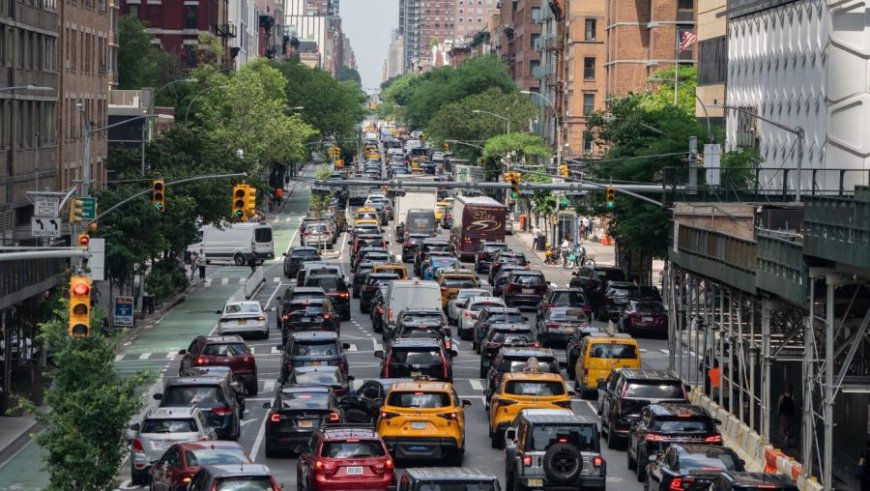Congestion pricing is working in New York, and it proves government can do big things
Let’s learn the right lessons from this win and make it easier to achieve the next one.

In a moment when good government can feel out of reach, New York’s congestion pricing program proves something rare and powerful: We can still do big things.
Policy debates in New York often take on a larger-than-life quality, with every decision under a national microscope. Nowhere is that more true than in the area of transportation. From celebrities showing up at town halls about bike lanes to viral videos of subway breakdowns, transit policy here tends to provoke big reactions.
Still, I was surprised that congestion pricing — a straightforward tolling and traffic management program — has captured such national attention. The program has already delivered tangible benefits in just six months. And despite legal threats from the Trump administration, its hand is weak — as its own attorneys have admitted — and the signs are good that this program will continue.
As we celebrate this success, it’s worth reflecting on how we got here.
Congestion pricing has been one of the most fiercely contested and arguably most successful local policy wins in recent American history. My experience in working to pass and implement it offers important lessons for the future of progressive policymaking. Because what happens here reverberates nationally, we must draw the right conclusions — not just to protect it, but to replicate it.
First, progress is possible — and the public will come around. Like the Affordable Care Act, congestion pricing was initially unpopular. It polled terribly. After all, who wants to pay more for anything at a time of rising costs? But with determined advocacy, committed leadership and early results, public opinion is shifting in the program’s favor. Even commuters into Manhattan from my neighborhood in northern New Jersey are praising the program in casual conversations. And as transit service and reliability improve, support will likely continue to grow.
Public opinion matters, but it shouldn’t stop us from acting. It should shape how we make the case, not keep us from pursuing bold ideas.
Second, we need to deliver progress faster. Congestion pricing passed into law in 2019, but it didn’t launch until this year. Why the delay? In part, it was due to a multi-year environmental review and engagement process that collected thousands of comments and modeled a wide range of program design scenarios.
Ironically, a policy designed to cut pollution and improve transit equitably was nearly derailed by procedural delays and a process meant to minimize environmental harm.
The first Trump administration slow-walked the review process, stalling implementation for years. More recently, New Jersey opponents nearly blocked the program in court by arguing the review was insufficient, even though it was one of the most thorough in recent memory.
To be clear, the environmental review process has critically important benefits. In this case, it brought environmental justice communities to the table and secured meaningful investments in pollution mitigation in places like the Bronx. But the system needs reform. Policies like congestion pricing should be given the benefit of the doubt. Policymakers need room to test new ideas and adjust without being paralyzed by process or fear of endless lawsuits.
Third, none of this would have happened without dedicated public servants. Across the city, the state, the Metropolitan Transportation Authority and the federal government, hundreds of staff made this work, even as political leaders came and went. I still recall sitting across from Trump appointees at the U.S. Department of Transportation in 2019 who asked city and state officials to explain how the environmental review process worked — a process through which they were supposed to be guiding us.
It shouldn’t have to be said, but it does: government functions best when it hires competent, mission-driven people. Investing in the public workforce isn’t a luxury; it’s essential to solving big problems.
Finally, coalitions win. Yes, this was a long and hard-fought victory for transit advocates. But it was also a victory for the broad, diverse coalition they built. Support came from business leaders, real estate stakeholders and others across New York’s civic landscape. That consensus helped congestion pricing rise to the top when the state leaders needed to find money to rescue the MTA after 2017’s Summer of Hell.
Coalition-building takes time. It requires compromise. But it’s almost always necessary to achieve lasting change. That doesn’t mean sacrificing our values, but it does mean thinking strategically about who holds power, what they care about and how to build a winning alliance.
Congestion pricing is working. It’s delivering cleaner air and better transit. Delivering results quickly has to be the norm, not the exception. Now more than ever, we need examples of government delivering real, tangible benefits for everyday people. That requires bold ideas and a clear path to make them real.
Let’s learn the right lessons from this win and make it easier to achieve the next one.
Justin Balik is state vice president at Evergreen Action. He was formerly director of state and federal affairs for the New York City Department of Transportation, where he worked to pass and implement congestion pricing.
What's Your Reaction?
























